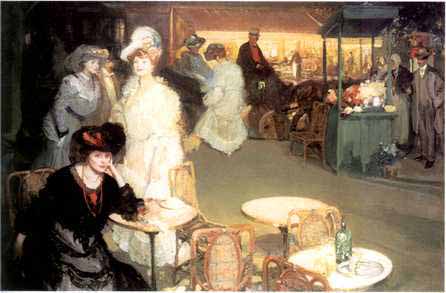
The
Bohemian
Life
by:
Stephen Siff
In 1881, when Puccini was an impoverished music student at the Royal Conservatory of Music in Milan, he rented a small room with his younger brother, who was also a music student, and a poor cousin. The boys were forbidden by their landlord to cook in their room, but eating out was a luxury beyond their means. Later in life, Puccini would fondly recollect how his roommates cooked while he banged out tunes on the piano as loudly as he could in order to cover the sounds of dinner being prepared. This lifestyle of students and artists who depended less on money than on their wits and sense of humor to survive became known as the "bohemian" life. Puccini reflects on this period of his life in the struggling bohemian characters of his opera LA BOHÈME (the title actually means "The Bohemians"): Rodolfo, a poet; Schaunard, a musician; Colline, a philosopher and Marcello, a painter. Puccini and his friends were part of a tradition of young poor artists surviving outside mainstream society and "paying their dues", a tradition which lasts to this day.
The term "bohemian" was originally used to describe the gypsies who entered western Europe through the central European kingdom of Bohemia. (Bohemia was an independent kingdom from approximately 1200-1400, located in what is now the Czech Republic.) Until this century, when many gypsies were killed in Hitler's concentration camps, gypsy family groups could be seen wandering all across Europe in colorfully decorated horse-drawn wagons, living for only a short time in one town or village before moving on to the next. The gypsies did not have regular jobs like the farmers and shopkeepers whom they met on their travels. They earned money as musicians, performers, entertainers, and peddlers. The gypsies also had a reputation as thieves, probably in part deserved, and in part the result of townspeoples' suspicion of anyone who had no permanent home or employment.
By the early nineteenth century, the term "bohemian" had lost much of its original association with the gypsies and was used to describe the loose communities of people in urban Paris who survived without taking traditional employment.
Alexandre Privat d'Anglemont characterized these underworld figures as industrious, honest, and hard working people who served society by filling in the small gaps overlooked by traditional commercial establishments. For example, he described one man who made his living collecting stale bread crusts to sell as croutons and pet food, and another who bred fisherman's bait worms in dung-filled attics across the city. Although their work falls outside the scope of traditional business practices, according to d'Anglemont they filled a useful role by providing the city with low cost croutons and bait worms. This portrait of the honest, hard working bohemian was treated with skepticism by the Parisian courts of the time, who saw these tales of late night industriousness as the cover stories of con men and crooks.
The term "bohemian" also came to encompass a counterculture of young, undiscovered artists. These bohemians tried to isolate themselves from the regular world of commerce and 9 to 5 jobs. They worked only as much as was necessary to survive, and focused their energy on their art and their personal lives. These artists were different from previous generations of successful artists in that they positioned themselves outside society, a position they considered virtuous. Social nonconformity was their code of conduct. Before this time, artists were generally employed by wealthy secular or church royalty, and later by businessmen, theatres or publishers, to produce their art. For the bohemians, however, living their lives as artists became an art in and of itself. They found poetry and beauty in their romances and dinner conversations, perhaps even more so than in their workday production.
This self-conscious attitude can be sensed in the first scene of LA BOHÈME, as Rodolfo and Marcello decide to burn the manuscript of one of Rodolfo's dramas in order to keep warm on a cold winter night. This could be a very sad and desperate moment, as Rodolfo sacrifices the one copy of his play, probably weeks of hard work, for a moment of comfort. But Rodolfo and Marcello are swept up by the poetry of the act, as Rodolfo gleefully proclaims: "The manuscript will turn to ashes page by page, and my poetic frenzies shall reascend to their heavens. Their loss threatens the century, and Rome totters!" The two bohemians are fully aware of the poetic value of the moment, which they esteem more highly than the printed poetry contained in the manuscript itself.
The popular success which greeted Murger's portrayal of the bohemians in his novel Scenes de la Vie de Boheme (see The Genesis of LA BOHÈME), had something to do with the attitude of his French audience. During a period of sixty years, beginning with the very bloody French Revolution in 1789, France had seen the rise and fall of several governments, most recently the installation of the Second Republic in 1848. The French people were tired of politics and the seemingly endless political turmoil, and were ready to turn away from the confusion and disappointment of public life, and focus on more personal pleasures.
The image of the young, struggling bohemian artists in Puccini's LA BOHÈME remains a part of our perception of artists to this day. In the late 1950's and early 1960's, the bohemian way of life came back into the spotlight. New bohemians like the poet Allen Ginsberg and the novelist Jack Kerouac composed very subjective and individualistic works during a period when most of the United States was characterized by tradition and conformity. Neighborhoods in New York City and San Francisco flourished as centers of bohemian life which evolved into the hippie movement.
The influence of Rodolfo and Marcello and their bohemian friends throughout history can be observed today whenever one is filled with the desire to stand apart and to express oneself as an individual.